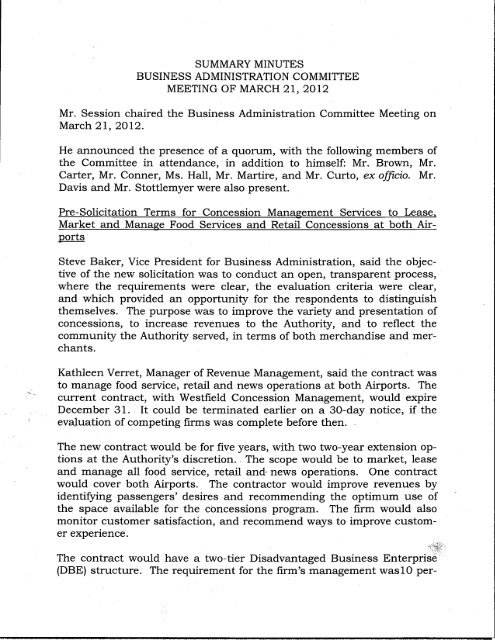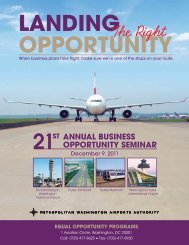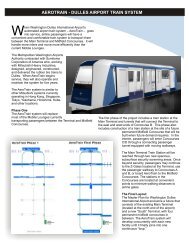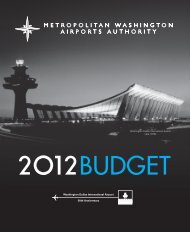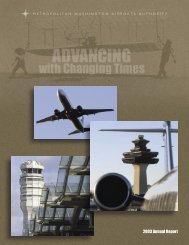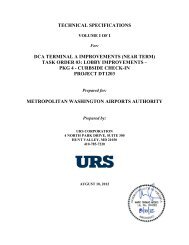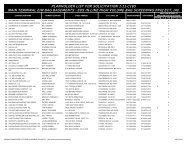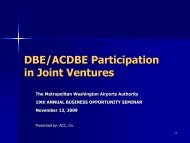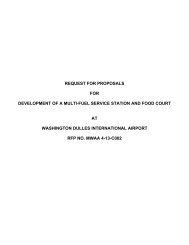Tab A-2 - Metropolitan Washington Airports Authority
Tab A-2 - Metropolitan Washington Airports Authority
Tab A-2 - Metropolitan Washington Airports Authority
You also want an ePaper? Increase the reach of your titles
YUMPU automatically turns print PDFs into web optimized ePapers that Google loves.
SUMMARY MINUTES<br />
BUSINESS ADMINISTRATION COMMITTEE<br />
MEETING OF MARCH 21,2012<br />
Mr. Session chaired the Business Administration Committee Meeting on<br />
March 21,2012.<br />
He announced the presence of a quorum, with the following members of<br />
the Committee in attendance, in addition to himself: Mr. Brown, Mr.<br />
Carter, Mr. Conner, Ms. Hall, Mr. Martire, and Mr. Curto, ex officio. Mr.<br />
Davis and Mr. Stottlemyer were also present.<br />
Pre-Solicitation Terms for Concession Management Services to Lease,<br />
Market and Manage Food Services and Retail Concessions at both <strong>Airports</strong><br />
Steve Baker, Vice President for Business Administration, said the objective<br />
of the new solicitation was to conduct an open, transparent process,<br />
where the requirements were clear, the evaluation criteria were clear,<br />
and which provided an opportunity for the respondents to distinguish<br />
themselves. The purpose was to improve the variety and presentation of<br />
concessions, to increase revenues to the <strong>Authority</strong>, and to reflect the<br />
community the <strong>Authority</strong> served, in terms of both merchandise and merchants.<br />
Kathleen Verret, Manager of Revenue Management, said the contract was<br />
to manage food service, retail and news operations at both <strong>Airports</strong>. The<br />
current contract, with Westfield Concession Management, would expire<br />
December 31. It could be terminated earlier on a 30-day notice, if the<br />
evaluation of competing firms was complete before then. -<br />
The new contract would be for five years, with two two-year extension options<br />
at the <strong>Authority</strong>'s discretion. . The scope would be to market, lease<br />
and manage all food service, retail and, news operations. One contract<br />
would cover both <strong>Airports</strong>. The contractor would improve revenues by<br />
identifying passengers' desires and recommending the optimum use of<br />
the space available for the concessions prograi. The firm would also<br />
monitor customer satisfaction, and recommend ways to improve customer<br />
expenence.<br />
~i~i:fff~::<br />
The contract would have a two-tier Disadvantaged Business Enterprisé<br />
(DBE) structure. The requirement for the firm's management was10 per-
cent LDBE, for the sublease contracts with food service vendors, 35 percent<br />
Airport Concession Disadvantaged Business Enterprise (ACDBE),<br />
and for retail, 25 percent ACDBE.<br />
The Request for Proposals (RFP) required a minimum level of experience<br />
in the management of food and retail operations, a threshold level of financial<br />
soundness, and a performance guarantee. The evaluation would<br />
be based on three basic criteria: the financial proposal, how much the<br />
firm would charge to manage the program; the development and implementation<br />
plan; and property management, marketing advertising and<br />
promotion.<br />
The plan was to issue the RFP in April, with responses due in June. The<br />
staff would have a recommendation for the Committee in August, and the<br />
Board would consider it at its September Meeting.<br />
Mr. Carter said the Directors were concerned and focused on quality of<br />
service as well as increased revenue. He asked what was different about<br />
the current RFP from the previous one. Ms. Verret said the differences<br />
were not great. The new RFP would require the improvement of all retail<br />
merchandising units at both <strong>Airports</strong>. The contract would set a floor on<br />
the investment in those improvements. This issue was very important at<br />
Reagan NationaL. The prevailing firm would also have to keep up with<br />
trends at other airports. . Finally, the- new RFP was much clearer about<br />
what was being evaluated. Mr. Baker pointed out that operating rules<br />
for the businesses would no longer be included in the contract, but in an<br />
<strong>Authority</strong> policy, which all would be obliged to follow.<br />
Mr. Carter said that it was a good idea to ask for five years of experience<br />
in the RFP, but was concerned that a requirement of five consecutive<br />
years might limit the number of respondents and perhaps favor the incumbent.<br />
Ms. Verret said that five years was necessar to evaluate an<br />
operation over time, especially when the RFP did not require airport expenence.<br />
Mr. Session pointed out that the Committee had delayed approval of the<br />
solicitation to the day's meeting so that the staff could address concerns.<br />
There had been a good discussion at the Februar Committee meeting.<br />
The original staff suggestion had been to issue an Invitation for Bids<br />
(IFB); it was now an RFP, which would facilitate competition. He noted<br />
that Westfield, the incumbent firm, had not had airport experience when
it was first selected; it had operated malls. It was important to spread<br />
the net as wide as possible.<br />
Mr. Session said he was concerned that the experience requirement was<br />
for five concurrent years of operations at two locations. Mr. Baker said<br />
the contract called for operating concessions at two locations 15 miles<br />
apart, and it was important to know that a firm could do that. Mr. Potter<br />
added that five continuous years was important because the staff did not<br />
want an operator that had been successful in the 80s. It was important<br />
to see how an operator had dealt with changing times, particularly<br />
through the recent recession. Ms. Verret added that the five consecutive<br />
years had to have occurred within the last ten years.<br />
Ms. Hall said there had been issues in the previous contract and asked<br />
what revisions had been necessar. Mr. Baker said the new RFP would<br />
try to make the <strong>Authority</strong>'s expectations clearer, especially in the areas of<br />
experience, to avoid arbitrariness. A more detailed answer would require<br />
an executive session.<br />
Mr. Session said that the contract would also be a partnership process.<br />
The contract would not be awarded, with the contractor then left to go its<br />
own way. There would be continuous contact.<br />
Mr. Martire asked if other airports used the same approach. Mr. Baker<br />
said every airport used a variation of the same theme. Staff had discussed<br />
the different models at the prior strategy meeting. There were a<br />
number of alternatives.<br />
Mr. Davis asked if the staff was confident this approach would produce<br />
the most revenues for the <strong>Authority</strong>. Mr. Baker said the most revenue<br />
could probably be obtained by limiting sales to hamburgers and t-shirts.<br />
The concession program tried to represent the region and to do more<br />
than just raise revenue. Thus he could assure the Committee that the<br />
new contract would produce much more revenue, but he could not say it<br />
was the highest revenue possible. Mr. Potter said there would be substantial<br />
improvements both on the revenue side and on the passenger<br />
satisfaction side.<br />
Mr. Carter asked about the selection process. Would a panel be established?<br />
Mr. Baker said the panel was one of the changes. More senior<br />
members would be appointed to it, and outside airport representatives<br />
would be added. The members of the panel would also be fully educated
on the process before the RFP responses were submitted, so they would<br />
know what they would be evaluating.<br />
Ms. Hall asked whether operation of a substantial mall would not be sufficient<br />
experience without operating two separate facilities. Mr. Baker<br />
pointed out that operating airport concessions was much more complicated<br />
than operating a mall. There was limited storage available, but at<br />
the same time the shops had to turn over far more products than at a<br />
malL. There were fewer downtimes at an airport than at a malL. Operationally<br />
an airport was more difficult than a mall, especially in terms of<br />
access. In addition, there were two separate sites. There would have to<br />
be two different management teams on site at the <strong>Airports</strong>; at a mall<br />
there was only one.<br />
Mr. Martire asked what approach the Pittsburgh Airport used. Mr. Baker<br />
said it was a developer modeL. The investment there was in the concession<br />
space itself. At the <strong>Authority</strong>, the stores were already built out; the<br />
carts were the only investment. Additional build-out was the responsibility<br />
of the tenants.<br />
Mr. Curto said the proceedings could be sped up by scheduling Board<br />
approval at the August meeting. Mr. Baker said the schedule was already<br />
tight and that he did not think it necessar.<br />
The Committee then voted to concur in the pre-solicitation terms.<br />
Recommendation to Award Contracts for Liquid Runway Deicer for both<br />
<strong>Airports</strong><br />
Chris Browne, Vice President and Dulles Airport Manager, said the proposal<br />
was to approve two contracts, one for each Airport, with Cryotech<br />
Deicing Technology of Fort Madison, Iowa, effective in August. The Business<br />
Administration Committee had concurred in the solicitation in July<br />
2011. The contract was for the manufacture and delivery of Federal Aviation<br />
Administration-approved liquid petroleum acetate, known as E-36.<br />
There had been four proposals, all qualified, and price had been the determining<br />
factor. The contracts were for a one-year base, with four oneyear<br />
extension options. The total cost for five years would be $5.5 million.<br />
Ms. Hall said the past winter had been mild, and had not required much<br />
deicing. She asked if there was a minimum payment when the product
was not needed. Mr. Browne said the <strong>Authority</strong> would only pay for what<br />
was used. He added that he had been concerned about the shelf life of<br />
the product. Memphis Airport had tested leftover deicer from 1999 and<br />
found it still effective. Thus the <strong>Authority</strong> could stock up on the product,<br />
and order more as it was needed. It was possible, though not likely, that<br />
more of the product would not be required for a year.<br />
The Committee then unanimously agreed to recommend that the Board<br />
approve the contract awards.<br />
Pre-Solicitation Terms for Two Requests for Proposals for Taxicab Service<br />
at Dulles International<br />
Mr. Browne said there were two solicitation processes for taxicab services<br />
at Dulles InternationaL. The first was to provide taxicab services under<br />
the <strong>Washington</strong> Flyer brand, by contracting with up to four taxicab<br />
fleets. The second was a contract with a firm to manage taxicab dispatch<br />
functions. The current contracts had run from Februar 2008 and<br />
would expire in January 2013. Three cab companies were currently under<br />
contract with 240 cabs each, for a total fleet of 720. Another firm<br />
handled dispatching, with a 25 percent DBE goal. The <strong>Authority</strong> collected<br />
$2.50 per outbound trip and an annual per taxicab registration fee of<br />
$1000 to $1500, based on each company's bid. In 2010 total gross receipts<br />
had been $9.7 million, of which $3.2 million had been paid to the<br />
<strong>Authority</strong> in concession fees..<br />
In September 2011, staff had conducted an outreach program to determine<br />
whether there was interest in LDBE participation in providing taxicab<br />
service. There had not been demonstrable interest.<br />
The current proposal was to contract with up to four taxicab firms, with<br />
an overall fleet increased to 820 cabs. The per-taxicab annual fee would<br />
be set at a minimum of $1000, the amount depending on bids. The dispatch<br />
fee would be increased to $2.65, and collected in-bound as well as<br />
out-bound. There would also be a new per-driver fee of $250. The evaluation<br />
criteria for the cab companies included plans for operations and<br />
management, the financial offer, industry experience and qualifications,<br />
past performance and financial ability to perform. The approach for the<br />
dispatch contract would be unchanged; the dispatch criteria were the<br />
operations and management plan, industry qualifications and past performance,<br />
operating budget and financial ability to perform, and finally<br />
the bid on a management fee.
Mr. Martire asked how long the dispatch fee had been $2.50; Mr. Browne<br />
said it had been in place since the beginning of the contract in 2008. He<br />
said that the <strong>Washington</strong> <strong>Metropolitan</strong> Area Transit Commission had approved<br />
an increase during the current contract, but it had not been implemented.<br />
Mr. Carter asked how the 25 percent DBE requirement would be met.<br />
Richard Gordon of the Equal Opportunity Office said it would have to be<br />
established by subcontract or joint venture; in either case, the DBE<br />
partner would have to play a substantial role in the management of the<br />
concession, not just an investment. Mr. Carter asked when the requirement<br />
would be imposed; Mr. Gordon said it would be required in a response<br />
to the RFP. The current dispatch firm, the same at both <strong>Airports</strong>,<br />
was 100 percent DBE. Mr. Session observed the DBE statute provided<br />
that any participating DBE had to perform a "commercially useful function"<br />
.<br />
Ms. Hall said she understood that cabs that did not belong to one of the<br />
four fleets could not line up in the queue to pick up passengers. Mr.<br />
Browne said that prearranged pickups could be made with cabs not in<br />
the Flyer fleets. But to enter the queue, a cab had to be a branded<br />
<strong>Washington</strong> Flyer taxi. Ms. Hall then said it appeared aD.C. cab delivering<br />
a passenger to Dulles International could not pick up an arriving<br />
passenger. Mr. Browne agreed, noting that a <strong>Washington</strong> Flyer cab<br />
could not make a pickup in the District of Columbia. He said the rules<br />
were regulatory and the <strong>Authority</strong> could not change them.<br />
The Committee voted to concur in the pre-solicitation report.<br />
Report on Signature Flight Support Fixed Base Operator Contract Option<br />
at Dulles International<br />
,<br />
Mr. Browne said the staff was planning to extend the contract option<br />
term for Signature Flight Support (Signature) at Dulles International<br />
from November 1, 2012 through October 31,2017, subject to three conditions:<br />
a defined capital investment in the facility, commitment to develop<br />
an aircraft maintenance repair overhaul facility, and adjusted rental<br />
provisions.<br />
Signature was one of two Fixed Base Operators (FBOs) operating at Dulles<br />
International to serve the needs of general aviation. Its current contract<br />
was for 15 years, from 1997 to October 31,2012. That contract in-
cluded a single five-year extension option. In 2002, the Board had approved<br />
a 30-year Supplemental Agreement to the Signature contract authorizing<br />
the firm to sublease a portion of its leasehold for the construction<br />
and operation of a corporate hangar facility, with support office<br />
space, by Landow Aviation Limited Partnership (Landow). The supplemental<br />
agreement provided for many operational and financial arrangements<br />
between Signature and Landow through the execution of the sublease,<br />
most notably Signature's exclusive right to provide fueling and<br />
other FBO services. As the supplemental agreement exceeded the term<br />
of the Signature concession contract, it could ultimately be assigned to<br />
Signature's successor or the <strong>Authority</strong>.<br />
In June 2011, staff had discussed with the Committee the Signature extension<br />
option period and a separate Landow proposal for a direct lease<br />
with the <strong>Authority</strong>. Staff conducted follow-up discussions with both<br />
firms. Later, Signature advised the <strong>Authority</strong> of its interest in adding a<br />
General Aviation Maintenance, Repair and Overhaul Facility (MRO) to its<br />
FBO operation. This would be a valuable addition to the Airport, as it<br />
would expand the services provided at Dulles International, attract new<br />
aviation users, provide Landow's Dulles Jet Center with new tenants,<br />
provide some incentive for development of the Western Lands, and motivate<br />
Signature to enhance its existing facilities.<br />
To develop this MRO, Signature had asked the <strong>Authority</strong> to exercise the<br />
five-year extension option and consider two more years beyond the five.<br />
Under the existing contract, the <strong>Authority</strong> could renegotiate the business<br />
terms to apply during the extension period. Staff proposed increasing<br />
the concession fees on fuel sales from 14 percent to 17 percent, and increasing<br />
the fuel flowage fee for "put-thru" fuel from 3cr to 17cr per gallon.<br />
These fees would match what the other FBO, Landmark Aviation, was already<br />
paying the <strong>Authority</strong>. In addition, the extension agreement would<br />
be contingent on the establishment of the MRO and a renovation capital<br />
investment of up to $2 million during the extra five years. The staff<br />
would maintain the Supplemental Agreement between Landow and Signature,<br />
and would not yet consider the additional two-year extension.<br />
Mr. Brown asked where the MRO would be. Mr. Browne said Signature<br />
would move the 11 aircraft currently based at its facility to the Landow<br />
facility. The MRO would be within the existing Signature footprint. Mr.<br />
Brown asked how the MRO would get to the Western Lands. Mr. Browne<br />
said it added another component. As the MRO was a new business,<br />
there would be greater interest in moving as it grew. Mr. Potter said ex-
tending Signature for five years gave the staff opportunity to pursue the<br />
Western Lands strategy. Mr. Brown said it had long been discussed how<br />
to get the FBOs out of the congested area around the Main Terminal and<br />
that he was concerned Signature would be too vested in the location with<br />
its MRO. Mr. Potter said the arrangement was a five-year deal; at the<br />
end of it, the Signature property reverted to the <strong>Authority</strong>. He also noted<br />
that Signature would probably not do the MRO work itself in any<br />
event.<br />
Further, within five years, it might be possible to land one of the larger<br />
anchor tenants in the Western Lands, which in turn would require full<br />
infrastructure in the area and make the FBO section of it more attractive.<br />
Ms. Hall asked if Dulles International would be unique for having both a<br />
major air carrier maintenance facility and a general aviation maintenance<br />
facility. Mr. Browne said it was unusual in the region. She then<br />
asked if the United Airlines facility would serve other carriers. Mr.<br />
Browne said the carrier could, but he did not believe it would. For that<br />
reason, Mr. Potter said, there could lJe a need for an additional facility for<br />
foreign carriers.<br />
Mr. Curto asked about the 11 tenants Signature would be relocating.<br />
Mr. Browne said it appeared the arrangements had already been made<br />
with Landow; two of the 11 had already moved. If any did not agree, they<br />
could always move to Landmark, assuming there was space available.<br />
Mr. Session asked whether the Board-approved 30-year Supplemental<br />
Agreement had included an MRO. Mr. Browne said the Agreement had<br />
allowed the establishment of special maintenance facilities, subject to<br />
<strong>Authority</strong> approval.<br />
The Committee then concurred in the proposed staff action.<br />
Recommendation to Establish Airport Concessions Disadvantaged Business<br />
Enterprise Program Goals for Federal Fiscal Years 2012-2014<br />
Mr. Baker explained that the proposal was to establish proposed goals<br />
for the concessions DBE program. They were required by federal rules to<br />
be set every three years. The process included examining the contracts<br />
to be solicited over the period and the availability of DBE firms to participate.<br />
Mr. Gordon explained that the requirement was to set a goal at each airport<br />
for ACDBEs other than rental cars, and a separate goal for rental
cars. There were two steps to determining the availability of ready, willing<br />
and able DBE firms. First, they had to be identified. Then they were<br />
measured as a percentage of all firms within their industry categories.<br />
The major upcoming concessions were the food and beverage and retail<br />
contract and the duty free contract.<br />
The next step was to determine what in the marketplace would have a<br />
negative impact on the ACDBEs,such as lack of capital and competing<br />
opportunities. After considering this, they would combine existing concession<br />
DBEs and the new opportunities to establish the goals.<br />
The proposal was to set non-car rental ACDBE goals at 29 percent at<br />
Reagan National and 22 percent at Dulles International. The goals for<br />
rental cars were 10 percent at both <strong>Airports</strong>. The goals were the same as<br />
for the last three years, except for Dulles International, which had gone<br />
up 3 percent. But achievements for Reagan National had been 32.6 percent<br />
over the three-year period, and Dulles International had achieved<br />
33.3 percent.<br />
Mr. Carter said the <strong>Authority</strong>'s percentages were impressive, and asked if<br />
there was an opportunity to compare the ACDBE performance with that<br />
of other airports. Mr. Gordon said it could be done, but had not been<br />
done recently. Mr. Potter said the staff would get the numbers for the<br />
Committee.<br />
Mr. Conner asked what the achievement numbers for the car rental<br />
DBEs had been; Mr. Gordon said they had been less than 1 percent. The<br />
staff kept the goal at 10 percent as it worked on the problem. If the rule<br />
were changed from measuring gross receipts to just supplies, the goal<br />
would make more sense.<br />
Ms. Hall asked why the goals were not higher when they were being exceeded.<br />
Mr. Gordon said the goals were based on a statistical calculation,<br />
which only changed when obstacles to participation showed up.<br />
The achievements had been the result of outreach, and active efforts by<br />
Westfield in recruiting qualified DBEs. The Department of Transportation<br />
rules called for the statistical basis for goals; the Department knew<br />
the <strong>Authority</strong> could do better, and encouraged it to do so.<br />
Mr. Session said he had attended many Airport Minority Advisory Council<br />
conventions and had heard the Department of Transportation focus
- J_<br />
on statistics. Because the availability of firms played such a large role in<br />
the equation, it would be difficult to compare the <strong>Authority</strong>'s goals to<br />
those of other metropolitan areas. <strong>Authority</strong> goals would compare favorably<br />
to airports in the Midwest, but perhaps not with Atlanta or others in<br />
the South.<br />
The Committee then voted to recommend the goals to the Board.<br />
Review of 2012 Contracting Actions Affecting the Traveling Public<br />
Mr. Baker said the contracts addressed were less than $3 million, which<br />
meant they did not require Board approval, but did have an effect on the<br />
traveling public. They were presented for information; if there were not<br />
any concerns or questions, they would proceed through the procurement<br />
process.<br />
Fred Seitz, Manager of Procurement, said the report was made annually.<br />
There were four such contracts anticipated for 2012:<br />
. the Airport Consultant, currently Leigh Fisher, a service supporting<br />
bond issuances and airline rates and charges, costing approximately<br />
$500,000;<br />
. Banking and ATMS, the banks at both <strong>Airports</strong>, currently Capital<br />
One, generating about $663,000;<br />
. Foreign Currency Exchange at both <strong>Airports</strong>, currently operated by<br />
Travelex Currency Services, generating about $1.25 million annually;<br />
and<br />
. the Reagan National FBO, currently operated by Signature, and<br />
generating about $843,000 annually.<br />
RFPs would be undertaken for the first three contracts. The FBO would<br />
be discussed at a future Committee meeting.<br />
Mr. Brown asked about the outlook for real competition for the airport<br />
consultant contract. Ms. McKeough said last time the staff had checked<br />
the market it had appeared there were two major firms in the business.<br />
There would still be a full and open competition in the hopes of more interest.<br />
Mr. Brown said the market was always shifting, with people<br />
breaking off from one firm to start up another.
Option Year Contracts Requiring Committee Review, April through December<br />
2012<br />
Mr. Baker explained that the Board had decided a few years ago that it<br />
would review contracts before extension options were exercised when the<br />
Board had approved the initial contract. Management was recommending<br />
extension of all the contracts on the provided list.<br />
Mr. Seitz went through the list of contracts, which would expire in the<br />
second through the fourth quarter of 2012:<br />
. Air Services Development Consultant - Oliver Wyman of Reston;<br />
exercise of the second of two one-year options effective Januar 1,<br />
2013. The cost was $500,000 per year, with a 25 percent LDBE<br />
requirement.<br />
. Reagan National Custodial - Motir Services of <strong>Washington</strong>, D.C.;<br />
exercise of the second of three one-year options effective July 1,<br />
2012. The cost was $5 million per year, a 100 percent LDBE setaside.<br />
Mr. Curto asked for an explanation of the living wage standard for the<br />
Motir contract and when it was last changed. Mr. Seitz said the last time<br />
it was changed was the year the contract began; living wage under the<br />
<strong>Authority</strong>'s policy was set when a new solicitation was issued. The number<br />
was an average of local jurisdiction living wages; it was currently<br />
$12.80 per hour. The staff<br />
would look at the living wages again when the<br />
option year was exercised. Mr. Seitz said there were seven contracts<br />
subject to the living wage requirement.<br />
. Reagan National Unarmed Guard - Master Security of Hunt Valley,<br />
Marland; exercise of the second of four one-year options effective<br />
November 1, 2012. The cost was $1.7 million per year, a 100 percent<br />
LDBE set-aside. i<br />
. Reagan National Elevator, Escalator and Moving Walkway Maintenance<br />
- Schindler of Beltsville, Marland; exercise of the first of<br />
four one-year extension options, effective November 1, 2012. The<br />
cost was $2.1 million per year, 20 percent LDBE requirement.<br />
. Dulles International Elevator, Escalator and Moving Walkway<br />
Maintenance - Schindler of Beltsville, Marland; exercise of the<br />
third of four one-year options effective July 1, 2012. The cost was<br />
$4.2 million per year, 20 percent LDBE requirement.
. Dulles International Natural Gas - Columbia Gas of Virginia of Columbus,<br />
Ohio; exercise of the first of two two-year options effective<br />
September 1, 2012. The cost was $3.5 million per years, no LDBE<br />
requirement.<br />
Mr. Curto asked if there were any questions about the remaining three<br />
contracts. There were not any.<br />
Mr. Session said he had benefited from advance discussions with senior<br />
staff, which had enabled the meeting to move along smoothly.
SUMMARY MINUTES<br />
DULLES CORRIDOR COMMITTEE<br />
MEETING OF MARCH 21,2012<br />
Mr. Davis chaired the March 21, 2012 Dulles Corridor Committee Meeting.<br />
He verified the presence of a quorum.<br />
Pre-Solicitation for Selection of an Architectural/Engineering/Planning<br />
Consultant for Task Planning Services for the Dulles Toll Road. The<br />
meeting began with a pre-solicitation report on a task services contract<br />
for the Toll Road. Steve Smith, Deputy Vice President for Engineering,<br />
explained that the prevailing firm would provide consultant services to<br />
the Planning Department and other offices on capital renewal, replacement,<br />
redevelopment and strategic planning on the Toll Road. The contract<br />
would be for one year with two one-year extension options. It would<br />
have an annual ceiling of $2 million, and a 35 percent Local Disadvantaged<br />
Business Enterprise requirement. The evaluation would be based<br />
on the key personnel available, experience and qualifications, and past<br />
performance of the company. A Technical Evaluation Committee would<br />
rank the firms. Negotiations would begin with the highest-rated firm,<br />
based upon standard industry rates for the type of work. If necessar,<br />
staff would then go to the second-ranking firm. Finally, the proposed selection<br />
would be brought to the Committee and the Board for approval.<br />
The Committee concurred in the proposed procurement.<br />
Dulles Corridor Metrorail Project Monthly Cost Summar. Pat Nowakowski,<br />
Executive Director of the Metrorail Project, reported that expenditures<br />
for the month of Januar had been $66.2 million, bringing the total<br />
to $1.771 billion, against the budget of $2.755 billion. The estimated<br />
completion cost remained at $2.905 billion, including contingency.<br />
In Januar, $1.6 million of contingency had been used, consisting of a<br />
$1.1 million adjustment in the utility relocation forecast and miscellaneous<br />
charges. With a total use of $269.9 million in contingency, $42.4<br />
million remained. The completion date was still August 2013.<br />
Februar 2012 Financial Report - Dulles Corridor Enterprise. Andy<br />
Rountree, Vice President and Chief Financial Officer, said the year-todate<br />
Februar revenues, at $16.2 million, had increased 12.3 percent<br />
over the same period in 2011. Mr. Davis asked if the completion of construction<br />
on the 1-495 HOT Lanes had encouraged more traffic. Mr.<br />
Rountree said it probably had. The increase in revenue had come from
the 2011 toll increase. Revenue had reached 15.1 percent of projections<br />
at 16.2 percent of the year. There had been 16 million transactions yearto-date,<br />
up 2.1 percent, compared to the budget projection of 1.8 percent.<br />
Electronic collections had increased 3.3 percent to 78 percent of all<br />
transactions.<br />
Expenses year-to-date had been at $4.3 million, up 11.2 percent from<br />
2011 because of a timing difference for the posting of allocated expenses.<br />
Expenses were, however, only at 14.8 percent of budget. Days of unrestricted<br />
cash on hand were up from 769 in December 2011 to 811. Mr.<br />
Davis asked if the number of drivers diverted by the toll increase<br />
matched projections. Mr. Rountree said transactions were still up 2 percent.<br />
Mr. Davis asked if the end of construction had helped. Mr.<br />
Rountree said it had helped considerably. He said the fact that revenues<br />
were still a bit short of projections suggested that there was more ramp<br />
activity, as opposed to mainline activity.<br />
Mr. Cobey observed that North Carolina was opening its first toll road,<br />
part of the outer loop in Raleigh. The new road did not have any toll collectors.<br />
Drivers paid electronically, or had their license plates photographed,<br />
which led to a bill. He asked if a similar approach would be<br />
taken on the Toll Road. Mr. Rountree said it would. At a future meeting<br />
staff would present the alternative collection systems they had been discussing.<br />
Mr. Potter said one the major issues for the North Carolina<br />
style of tolling was leakage. There were not any interstate agreements<br />
that would enable the collection of tolls from license plates of drivers<br />
from other jurisdictions. This would be a particular problem in the<br />
<strong>Washington</strong> area. Mr. Curto observed that the InterCounty Connector in<br />
Marland used the same approach as North Carolina.
SUMMARY MINUTES<br />
FINANCE COMMITTEE<br />
MEETING OF MARCH 21,2012<br />
Mr. Conner chaired the March 21, 2012 Finance Committee Meeting. All<br />
members of the Committee attended: Mr. Brown, Mr. Carter, Mr. Conner,<br />
Mr. Davis, Ms. Hall, Mr. Session, Mr. Snelling and Mr. Curto, ex officio.<br />
Mr. Martire and Mr. Stottlemyer were also present. Mr. Conner announced<br />
that the first item on the agenda, Policy Considerations for Near-<br />
Tenp. Dulles Toll Road Rates, would be deferred to the April meeting. The<br />
selection of underwriters, the next item on the agenda, would require an<br />
executive session.<br />
The Committee thereupon went into executive session at 1:02 p.m. At<br />
1:47 p.m., the Committee returned to regular session.<br />
Selection of Syndicates for Investment Banking<br />
Mr. Conner said the Committee had discussed in executive session the<br />
underwriting firms staff had proposed for the upcoming aviation and toll<br />
road bond issuances. There would be two separate syndicates, one for<br />
the Aviation Enterprise and one for the Dulles Corridor Enterprise. He<br />
said a proposed resolution had been prepared, and called for a vote on it.<br />
Mr. Carter moved approval of the resolution and recommendation to the<br />
Board. Mr. Conner asked Andy Rountree, Vice President and Chief Financial<br />
Officer, to read the names of the firms in the proposed resolution.<br />
Mr. Rountree said 38 firms had participated in the selection process, an<br />
unprecedented number, and thanked all the firms that submitted qualifications.<br />
He then read the following list of firms:<br />
Aviation Enterprise Dulles Corridor Enterprise<br />
Barclays Capital<br />
Bank of America/ Merrill Lynch<br />
Citigroup<br />
US Bancorp<br />
Davenport<br />
Morgan Keegan<br />
Loop Capital<br />
Sie bert Brandford Shank<br />
Bank of America<br />
Goldman Sachs<br />
JP Morgan<br />
Morgan Stanley<br />
RBC Capital<br />
BB&T Capital<br />
Fidelity Capital<br />
Janney Montgomery<br />
Piper Jaffrey<br />
Loop Capital<br />
Sie bert Brandford Shank
Mr. Conner thanked all the bankers who had followed the <strong>Authority</strong> and<br />
offered new ideas for financing. He noted that a decision had to be made,<br />
and the syndicates could not include all firms. He called for a vote, noting<br />
that it would be a recommendation to the Board, to be considered at<br />
the April Board Meeting. Mr. Carter's motion was approve unanimously.<br />
Mr. Conner noted that the Request for Qualifications (RFQ) for the investment<br />
banking services had included a blackout period during which<br />
bankers were not to contact Board and staff; it would continue until the<br />
Board voted. The selection of book-running senior managers for each<br />
team would be made later.<br />
Quarterly Investment Committee Report<br />
Mr. Rountree indicated that the Report would cover the final quarter of<br />
2011, ending December 31. From September 30, 2011, the portfolio had<br />
decreased $371 million to $1.591 billion.<br />
The Aviation portfolio as of December 31, 2011 had been $1.1 billion,<br />
down $170 million from September 30, 2011. The change was in largest<br />
part from continued construction spending, but there had also been the<br />
usual heavy debt interest and principal payment on October 1, 2011. An<br />
annual evaluation of the debt service reserve accounts had also allowed<br />
the shifting of an additional $18 million to the construction funds.<br />
The Dulles Corridor portion of the portfolio had dropped $202 million because<br />
funds had been transferred to other accounts. $32 million had<br />
been pulled into other required reserve accounts. This had fully funded<br />
an account for latent defects, for the benefit of the <strong>Washington</strong> <strong>Metropolitan</strong><br />
Area Transit <strong>Authority</strong> (WMATA), to pay for defects that may be discovered<br />
after the rail service begins. Construction spending during the<br />
quarter had principally used federally reimbursed funds. A $26 million<br />
debt service interest payment had been made on October 1, 2011.<br />
A balance sheet calculation of days of unrestricted cash-on-hand showed<br />
that the <strong>Authority</strong>'s aviation balance, at 406, was below the 489 median<br />
of all airports. This figure would be watched carefully during budget development.<br />
Days of unrestricted cash was not a problem on the Toll Road because<br />
the cash coming in was quite high compared to the operating budget of<br />
the Road, as required to fund metrorail project and other corridor improvements.<br />
The cash-on-hand number was well above the median for all<br />
toll roads.
Mr. Brown said he had mentioned late last year his concern about the investment<br />
committee as a management committee and its tendency to diffuse<br />
responsibility. Other tasks were assigned to specific officers, not<br />
committees. He was especially troubled by a staff committee where there<br />
was no expertise. The Chief Financial Officer should be directly responsible<br />
for investments. He said he hoped the Finance Committee would<br />
still consider reform. Mr. Conner said the comments were fair, and that<br />
the Committee would be considering it.<br />
Mr. Curto noted that the October debt payment seemed large. Nancy<br />
Edwards, Manager, Treasury Department, said debt principal was paid<br />
once a year, interest twice. On October 1, 2011 both principal and interest<br />
were paid, so the payment was large. Money had been set aside to<br />
pay for it when it came due; the size was not a problem.<br />
Financial Advisors' Report - Aviation Enterprise<br />
Guy Nagahama reported on the visits to the rating agencies in New York.<br />
He pointed out that Moody's still had "negative outlook" attached to the<br />
<strong>Authority</strong>'s rating. Moody's would resolve that outlook in 2012, either by<br />
taking a rating action or by affirming the current rating. In addition, with<br />
respect to the refunding savings possible in a 2012 financing, rates were<br />
increasing. A combination of confidence in the economic recovery and an<br />
additional supply of municipal sales had increased rates by 25 to 45<br />
points. Last month the net present value savings to be realized as a result<br />
of a potential refunding had been estimated at $36 million; now the<br />
estimate was $25 million. The Advisors were discussing with the financial<br />
staff alternate structures for the bond issue. The current schedule<br />
for the 2012 issuance was to go to market as soon as possible, with a<br />
presentation to the Finance Committee in May and a potential sale in<br />
June.<br />
Financial Advisors' Report - Dulles Corridor<br />
Bryan Grote said most items in the report had been covered already, and<br />
turned to news stories. In February, the u.s. Department of Transportation<br />
had announced that in response to its annual solicitation, it had received<br />
26 more letters of intent for Transportation Infrastructure Finance<br />
and Innovation Act (TIFIA) assistance, requesting about $13 billion. This<br />
was consistent with applications in previous years. Mr. Grote pointed out<br />
that the Dulles Metrorail project, at $1.9 billion, was not the largest applicant;<br />
the Pod Train Superhighway in San Diego and the Tappan Zee<br />
Bridge in New York had both sought more TIFIA than the Dulles project.
Two other projects were seeking $1 billion. Moreover, 15 of the 26 applications<br />
were repeats from 2011, including the <strong>Authority</strong>'s.<br />
In Virginia, a similar discussion was under way on toll support for the<br />
Midtown Tunnel Corridor between Norfolk and Portsmouth. As with the<br />
Metrorail project, the question was how much the Commonwealth would<br />
contribute to reduce the tolls on that facility. In December 2011, the<br />
Governor had promised $362 million to the $1.9 billion project, to keep<br />
the tolls below $2. Legislators were seeking more, $500 million, to bring<br />
the toll down another 50 cr.<br />
Mr. Brown noted that the $3 billion Dulles rail project had been promised<br />
$150 million, while a project further south two-thirds the size already had<br />
more than twice the commitment. The <strong>Authority</strong> should not be embarrassed<br />
about asking for a larger contribution from Richmond.<br />
Doreen Frasca said that she had attended the rating agency presentations,<br />
and that the staff been extremely impressive. Addressing the market,<br />
she said that the MMD rates had been the lowest since the index was<br />
established in 1981. March had not been good, with too many public<br />
agencies trying to take advantage of the lower rates.<br />
Mr. Session asked when the Transportation Department would respond<br />
to the TIFIA applications. Mr. Grote said he expected decisions before the<br />
end of the year.<br />
February 2012 Financial Report - Aviation Enterprise Fund<br />
Mr. Rountree reported year-to-date revenues of $106.4 million, up<br />
10 percent from the same period of 2011. The figure was close to budget,<br />
16.3 percent of budgeted revenues at 16.7 percent of the year. Expenses<br />
for the same period had been $96.2 million, up 5.1 percent, at 16.7 percent<br />
of budgeted expenses. Operating income had been $10.2 millon,<br />
compared to $5.2 million for the same period in 2011. He said the most<br />
significant news was the debt service coverage, estimated at 1.33 as of<br />
Februar. As the staff worked through settlement of the 2011 figures, it<br />
appeared the coverage will now be closer to 1.37, better than previously<br />
reported. Days of unrestricted cash on hand were 438 at the end of Februar.<br />
Mr. Carter asked why the operating income was nearly twice the 2011<br />
leveL. Mr. Rountree said the weather had a major impact; adverse weather<br />
in 2011 drove higher expenses. He therefore thought the difference<br />
had been in expenses rather than income. Income from the airlines was
ased on cost reimbursement, and activity from airlines and non-airline<br />
business had been leveL.


